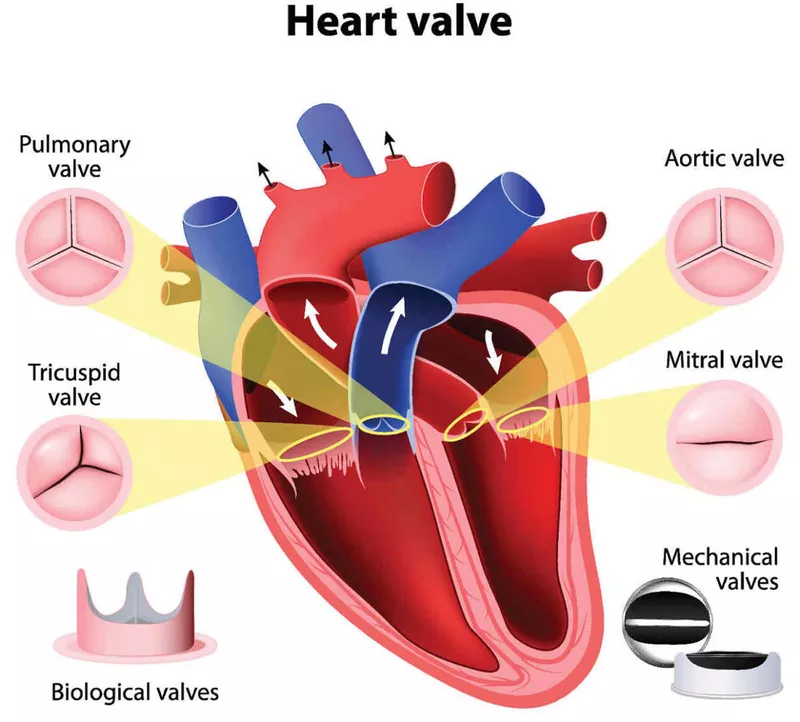Heart Valve Disease
The Keepers of Flow: A Comprehensive Guide to Heart Valve Disease
Your heart’s valves function as small gates to make sure blood flows in the right direction. Heart valve disease is the term used to describe this valve problem. This illness has the potential to impair blood flow, which could affect the heart’s effectiveness and cause problems. In order to help you comprehend and effectively manage heart valve disease, this blog post delves deeply into the specifics of the ailment, examining its forms, causes, symptoms, and available treatments.
Table of Contents

The Plumbing System of the Heart: Valves and Blood Flow
The Chambers of the Heart: The two upper atria and the two lower ventricles make up the four chambers of the heart.
The Switches: The heart’s four valves regulate blood flow:
- Mitral Valve: Assuring blood flow from the atrium to the ventricle during filling, it is situated between the left atrium and left ventricle.
- Aortic valve: It stops blood from returning to the ventricle after it has been pushed out and is situated between the left ventricle and the aorta, or main artery.
- Tricuspid Valve: Blood flows from the atrium to the ventricle thanks to the tricuspid valve, which is situated between the right atrium and the right ventricle.
- The pulmonary valve: which is positioned between the right ventricle and the pulmonary artery, stops blood from returning to the ventricle after it has been pumped to the lungs.
Heart Valve Disease Types: The Dysfunct Guardians
Heart valve problems can occur in several ways:
- Stenosis: Blood flow through the valve is restricted when the valve opening narrows.
- Regurgitation: Blood can flow backward when the valve isn’t closed tightly.
- Prolapse: An irregular bulging of the valve leaflets may result in leakage.
The following are a few typical forms of heart valve disease:
- Mitral Valve Prolapse: When the heart contracts, the mitral valve leaflets protrude back into the left atrium, which may result in a slight leakage.
- Aortic Stenosis: When blood flow from the left ventricle to the aorta is impeded, the aortic valve narrows.
- Mitral Regurgitation: Mitral regurgitation is the backflow of blood from the left ventricle into the left atrium due to a malfunctioning mitral valve.
- Tricuspid Valve Disease: This less common condition affects the right side of the heart and can cause either regurgitation or stenosis.
- Pulmonary Valve Disease: Rare, pulmonary valve disease can cause regurgitation or stenosis, which reduces blood flow to the lungs.
What Causes Heart Valve Disease: The Source of the Malfunction
Heart valve disease can be brought on by a number of factors:
- Congenital Heart Defects: Problems with the heart valves at birth might result in dysfunction.
- Rheumatic Fever: Heart valve damage might result from an untreated case of strep throat.
- Endocarditis: An infection that affects the lining of the inner heart can harm the heart valves.
- Degenerative Changes: The heart valves may inevitably deteriorate and stiffen with ageing, raising the possibility of stenosis.
- High Blood Pressure: Over time, damage to the heart valves might result from persistently high blood pressure.
Heart Valve Disease Symptoms: The Body’s Warning Signs
The kind and severity of cardiac valve disease can affect the symptoms. Here are a few typical indicators:
- Murmur: During a physical examination, a physician may use a stethoscope to listen for an irregular heartbeat, or murmur.
- Fatigue: The heart’s ineffective pumping may cause you to feel exceptionally exhausted.
- Breathlessness: Particularly when exerting oneself, as the heart finds it difficult to supply enough oxygen to the body.
- Chest Pain or Discomfort: Certain heart valve diseases might cause this, particularly after exertion.
- Palpitations: The sensation of irregular heartbeats, racing, or fluttering in the heart.
- Swollen Feet or Ankles: One possible consequence of heart failure is fluid accumulation, which can result in swelling.
- Lightheadedness or dizziness: If the heart’s pumping function is compromised, this could lead to a reduction in blood supply to the brain.
Rebuilding the Defenders: Heart Valve Disease Treatment Choices
The precise kind and severity of heart valve disease determine the course of treatment. Possible choices could be:
- medicines: Blood pressure medicines and diuretics to control fluid accumulation may be utilised.
- Procedures with Minimal Invasiveness: These methods, such as balloon valvuloplasty, are intended to open a constricted valve.
- Valve Surgery: To replace or repair a broken valve with a biological or mechanical valve, open heart surgery may be required.
- Monitoring: In certain situations, particularly those involving minor valve issues, routine monitoring with your physician may be adequate.


